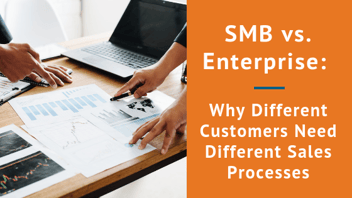Introduction
With thousands of new SMBs entering the market every day, they are pinning their success on technology like yours. However, technology brands tend to focus on what they know (enterprise sales), bypassing SMB prospects because they simply don’t know how to sell to them.
You don’t have to leave SMB revenue on the table. With the right approach and expertise, any company can boost its SMB sales and generate a substantial increase in revenue.
What Are SMBs?
SMBs are defined in terms of both size and revenue as they relate to IT requirements. What is considered a Medium-Sized Business? Any business with fewer than 100 employees is considered a small business, and any business with 100-999 employees is considered a medium-sized business.
Small businesses also tend to generate less than $50 million in annual revenue, and medium-sized businesses tend to generate between $50 million and $1 billion in annual revenue. However you define them, SMBs tend to have these same characteristics:
- They buy like consumers; they research before contacting vendors.
- They have a smaller group of decision makers, or, in many cases, the business owner is the sole decision maker.
- They have smaller IT budgets and are cautious about spending.
- They understand that choosing the wrong solution could be costly, so they don’t choose at all.
There are 30.7 million SMBs in the United States, making up 99.9 percent of all U.S. businesses. Despite having a smaller workload, 11 percent of SMBs are investing in technology, spending more than $1.2 million annually on cloud computing services alone. In fact, SMBs run 43 percent of their workloads in the public cloud and 35 percent in the private cloud—and SMB technology spending is only expected to increase.

The Roadblocks and Benefits of Selling to SMBs
Small and medium-sized businesses purchase differently than large enterprise organizations do.
Whereas larger organizations tend to have teams of decision makers representing various departments, SMBs have fewer decision makers—and in many cases, the owner is the sole decision maker.
Enterprise sales take substantially longer, largely because there are so many decision makers involved in the process. The sales rep needs to be prepared to focus on the long game, building relationships with key players, and making multiple presentations and demonstrations to satisfy everyone involved.
With SMB sales, the process is much shorter. Because there is usually only one decision maker, the sale can often be closed with the first demo.
The application of content as part of the sales process differs as well. Where the enterprise prospect wants to see more successful case studies of companies in similar markets and of similar size, the SMB buyer relies more on peer recommendations and trust as a result of their own research.
1. Time Constraints
SMB decision makers tend to be busy running their business and rely on strong partnerships and vendors to navigate upgrading their technology infrastructure. For example, 66 percent of SMB owners are responsible for three or more business areas, including:
-
Operations
-
Finance
-
Sales
-
Marketing
-
Human resources
-
Customer service
-
Product development
-
IT
This means that SMB buyers often have to research technology solutions in their spare time. As a result, an overabundance of information often clouds their ability to make a quick decision, especially when they feel that the wrong choice could be a setback for their business.
2. Risk Aversion
SMB owners are highly risk-averse. With smaller budgets than those of enterprise operations, SMBs are frequently bootstrapping operations and can’t afford to make a mistake when choosing technology. They are usually looking for solutions to well-understood problems and assurances that they are making the right choice.
For example, enterprise organizations tend to have vast amounts of data stored in different corporate siloes so that when they choose a customer relationship management (CRM) solution, they expect to invest in more expensive platforms that can handle data normalization and integration. SMBs don’t have the same problem and generally look for technology that they can deploy on the fly.
3. Budget Restrictions
SMB budgets are another consideration. The average SMB is spending between $10,000 and $49,000 annually on technology. However, IT budgets are increasing. Thirty-seven percent of companies with 99 employees or less, 47 percent of companies with 100-499 employees, and 51 percent of companies with 500-999 employees will increase their IT budgets in 2020.
"The average SMB is spending between $10,000 and $49,000 annually on technology."
4. Lead Scoring
Some smaller companies know what they need but don’t have the budget to make the move, or they are waiting for funding, or they are still refining their business model. That is why you need to use lead scoring and other strategies to make sure a lead is ready to buy and not just window shopping. In many cases, it’s best to keep your leads warm by providing ongoing information and continuing to educate them until they are ready to buy.
5. Right-Sized Selling
To make SMB sales profitable, you have to reduce selling costs. For example, using old-school solution-selling strategies, a sales rep would work with a prospect from lead generation through to final contract and onboarding. But this sales model is too costly for going after the SMB space.
The aim is to hire an experienced sales team, then equip them with the right tools, including a sales automation tool such as Outreach.io, to efficiently work through more leads and develop conversations with warm leads.
6. Lifetime Customer Value
In order to make your SMB sales initiative profitable, you need to match the value of the sales resource to the LTV of a customer. The basic formula for LTV is the sum of the length of time you have the customer plus the number of products they buy, offset by customer churn rate.

- ARPA is the average revenue per account
- Gross margin is the difference between revenue and cost of goods sold
- Customer churn rate is the rate at which customers cancel subscriptions
Calculating your customer acquisition cost (CAC) is equally important because you want to benchmark your CAC against your LTV to gauge profitability.

Ideally, you want a CAC: LTV ratio of 1:3, wherein $1 spent on CAC generates $3 of customer revenue.
In most cases, a high-touch sales process will result in a higher CAC and is not cost-effective. Outsourcing and automating lead generation and much of the SMB sales process can help you economize and minimize CAC against LTV.
The SMB Buyer’s Journey
One of the most significant changes in the SMB sales process is that the sale no longer ends when you sign the contract. More education and qualification go into the beginning of the sales process.
70 percent of the SMB Buyer’s Journey is complete before the SMB even contacts a supplier. The role of the seller has become more like that of a consultant rather than a vendor, with the focus on promoting Customer Success rather than just closing the deal.
By promoting Customer Success with your SMB customers, you create ongoing value, which drives recurring revenue and increases LTV.
Rather than a funnel, the sales process is now more circular. The process begins with the lead generation and qualification process, which leads to closing the deal. Then comes customer onboarding and ongoing support to cement the engagement, creating a brand evangelist. Then, the process starts all over again with upselling and cross-selling.
"The role of the seller has become more like that of a consultant rather than a vendor, with the focus on promoting Customer Success rather than just closing the deal."
The Five Stages of the SMB Buyer’s Journey
Here are the five common stages of the SMB Buyer’s Journey:
Step 1: Awareness
At the beginning of the SMB sales process, the SMB owner has identified a specific business need or gap and is seeking solutions. They may be conducting their own online research or have received a referral, but chances are that they come to the website looking for information about the right solution to their problem. At this point, you have captured the SMB lead as a potential buyer who needs to be educated until they are ready to buy.
Step 2: Consideration
Sometimes called the investigation stage, this is where the prospect narrows the scope of their search, looking for differentiators and capabilities that make your solution preferable to that of another vendor. In fact, Gartner reports that buyers only spend 17 percent of their time during the sales process actually meeting with vendors. After doing their research, they ultimately reach out for more detailed information and a demonstration.
Step 3: Commitment
Next comes the actual sale. Acting as a consultant allows you to continue to ask questions to understand why they approached you about your solution. This will help when setting expectations and identifying strategies to ensure ongoing Customer Success.
Step 4: Retention
Smooth deployment and onboarding is essential, so you want to start working closely with the customer as soon as the deal is signed. This requires answering all questions and ensuring that onboarding goes smoothly. The goal is to make customers happy so that they continue to come back for more. Current customers are 60-70 percent more likely to buy additional products, compared to 5-20 percent of prospects who will buy a new product.
Step 5: Advocacy
The goal is to ensure that the customer has had an ongoing, positive experience so that you can enlist them as a reference. Customer evangelists with positive testimonials can be your most powerful resource—and you may have to work hard to cultivate them.
How to Sell to SMBs
B2B buyers are presented with more market and product information than ever before, so it’s up to the sales team to help them interpret that data as it relates to their specific needs.

The sales team needs to deliver contextual support at each step of the customer’s journey, and the best strategy is to apply a more diversified approach, with specialists supporting the prospective customer at each step.
Start by rethinking the actual sales process and restructuring the sales team to better inform the customer by helping them find the right solution to their problem, reassuring them about their buying decision and continuing to support them to promote success and renewal.
For SMB sales success, consider restructuring your sales organization to accommodate these five trends:
-
Specialization: Whereas B2B sales reps used to be generalists, they now need to specialize to help the buyer at each step. At the beginning of the sales process, you want a customer development representative (CDR) for lead discovery and validation and to address initial questions. It’s at this stage that the buyer clearly defines their need and starts considering options.
When the prospect is qualified, an account executive (AE) or account manager (AM) is assigned to handle customer acquisition. After the contract is signed, a Customer Success representative (CSR) handles onboarding and adoption. By segmenting the process through specialization, the customer has a better experience and the best, most cost-effective sales resources are responsible for this at each step of the sales lifecycle.
-
Collaboration: The goal is to provide a frictionless buying experience. This requires that sales specialists work closely together. The CDR, AE, and CSR need to operate as a team, handling a common set of SMB customers and reporting to one sales leader.
By having the same sales specialists handle the same prospects and customers, there is better continuity and sharing of information. To encourage a collaborative approach, incentives should be awarded for team performance rather than individual sales—and this sales structure is scalable. You can move AEs and AMs to new teams without disrupting the sales process.
-
Advocacy: In the subscription economy, Customer Success has become more important than simply closing the deal. The goal is to advocate for the customer to make sure they receive maximum value from your solution. According to Forrester, the vendors with a strong Customer Success program are 54 percent more likely to retain 90 percent of customers.
What’s more, 80 percent of buyers say that the experience of working with the company is as important as its product or service. When you advocate for the customer, you build trust and create a tacit agreement that this business relationship is for mutual benefit. This makes it easier to deepen the relationship by upselling and cross-selling additional products. By partnering with the customer as an advocate for their success, you maximize customer satisfaction, improve retention, and increase LTV.
-
Efficiency: Restructuring the sales organization to focus on SMB success also increases overall efficiency, which cuts costs and increases profits. It’s about using the right resources to support each step of the customer’s journey.
To maintain a CAC:LTV ratio of 1:3, you need to streamline SMB lead generation and qualification to make it as cost-effective as possible.
Using CDRs supported by lead scoring and automated sales processes at the start of the sales process is a more efficient approach. The customer increases in value as they move through the sales lifecycle, and so you can use more expensive sales assets such as AEs and CSRs to enhance the customer experience and generate more revenue.
-
Personalization: Successful SMB solution selling requires building trusted relationships and providing personalized service. Each customer will bring problems that are relevant to their business model and market, so rather than selling by territory, it makes more sense to use personalized selling by industry.
Using industry experts with a background in a specific vertical, such as finance, education, healthcare, or technology, makes it easier to understand and empathize with the customer’s problem, speak their language, and offer the right solution. Using more collaborative sales teams organized by industry or specialization allows you to provide personalized service, build stronger customer relationships, improve customer satisfaction, and increase LTV.
As you re-organize your sales team, consider where you might outsource to lower CAC, increase efficiency, and create even more savings.
"To maintain a CAC: LTV ratio of 1:3, you need to streamline SMB lead generation and qualification to make it as cost-effective as possible."
Outsource Lead Qualification
According to a 2018 HubSpot State of Inbound report, 75 percent of respondents reported that closing more deals was their primary goal for the coming year, yet 40 percent of sales reps said getting a response from a prospect is harder than it was a few years ago, and 28 percent said that identifying and prospecting good leads is now more difficult.
Sales as a Service® providers already have the staff and processes in place to manage, nurture, and qualify leads, which can make outsourcing prospecting and qualification more cost-effective than maintaining an in-house sales team.
Leverage Vendor Technology
Similarly, you need technology to manage the sales process, including automating content management and lead generation, as well as CRM software and analytics.
Rather than licensing and training your in-house sales team, it makes more sense to outsource to a vendor that already has a comprehensive sales technology stack in place. Rather than automating and managing the processes and data gathering yourself, you can benefit from the results without having to pay for the software infrastructure.
Your objective is to use the most cost-effective lead-nurturing resources available to support SMB prospects until they are ready to become customers. Outsourcing the process is more efficient and gives you more flexibility.
By using a third-party Sales as a Service provider, you can:
- Qualify more leads
- Open new markets
- Experiment with new prices and product offerings
- Expand your sales operation without adding staff or overhead
- Support customer retention, upselling, and cross-selling
What to Look for in an SMB Sales Partner
A Sales as a Service partner can help you capture untapped revenue from the SMB market, but you have to find the right partner.
Seek out an outsourced sales company that has the expertise to function as an extension of your sales organization, along with the ability to support specialization, collaboration, advocacy, efficiency, and personalization.
Here are just a few capabilities to consider when looking for an SMB outsourced sales partner:
-
Understanding of SMBs: Look for a sales partner that has an intimate knowledge of SMB sales, including pain points, how SMB owners think, and what they want from a solution sale. SMB selling is different from selling enterprise customers, and you want to work with sales professionals who understand the differences and have mastered the art of SMB sales.
-
Industry expertise: Find a partner whose industry experts know how to sell to your target vertical markets, including understanding how to reach prospects in those markets and the challenges they face. To affect a positive impact on the customer during the sales process, expert industry sales reps need to be able to demonstrate a level of understanding and empathy that ultimately leads to a sale.
-
Shorten time to market: One of the primary reasons most organizations turn to outsourced sales is to shorten time to market. An outsourced sales organization already has the personnel, resources, and processes they need to ramp quickly.
-
Expand personnel: Hiring sales reps to expand your sales team is costly and time-consuming. For example, it takes 10 weeks of training on average for new sales reps, and even then, they don’t become productive for more than 11 months. It also costs $97,960 on average to replace a sales rep, and the average sales rep’s tenure is about 18 months.
An outsourced sales organization has a ready-made sales force and can train them in a fraction of the time. At MarketStar, for example, we can hire and train sales reps in 4-6 weeks and make them productive in less than six months.
-
Custom processes: No two sales organizations operate in the same way. Customers in different vertical markets also have different requirements. Your outsourced sales partner needs to be able to adapt to your internal processes and goals as well as changing market and customer needs.
-
Deliver revenue at scale: The rationale for engaging a Sales as a Service partner is to help your business grow faster than the cost of incremental sales resources. Your contract should be performance-based, with metrics to show that the outsourced sales relationship will increase in value and deliver more SMB revenue over time.
-
State-of-the-art sales tech stack: Another reason to hire an outsourced sales partner is to take advantage of their technology. Your partner should have all the software tools it needs to acquire, qualify, and track prospects, and the analytics tools to monitor sales performance and show you where you can improve.
The goal is to use their technology and benefit from the results rather than spend the time and training needed to deploy your own sales tech stack.
-
Deliver performance metrics: Analytics are an increasingly important part of any sales program. To make informed business decisions, you need better quality data, and your sales partner should be able to offer detailed data and analytics to not only demonstrate their own ROI, but also to measure CAC and customer LTV, and provide other metrics that gauge business performance.
"The rationale for engaging a Sales as a Service partner is to help your business grow faster than the cost of incremental sales resources."
Get Started: Find Success Selling to SMBs
SMB sales are very different from enterprise sales. The pain points differ. There are fewer decision makers, and the decision-making process is faster. At the same time, the lifetime value for SMBs is smaller than that of enterprise customers, and so customer acquisition costs need to be streamlined. At the same time, SMBs make up 99.9 percent of U.S. companies, and so the potential profits in SMB sales are too big to ignore.
If you understand those differences, you can adjust your sales tactics to open up new SMB sales opportunities. More organizations are discovering that outsourcing is the ideal way to penetrate the SMB market, lower their cost of sales, and develop a winning strategy that will yield ongoing revenue.
Let MarketStar show you how to capture SMB customers and maximize SMB profits. Let's talk!






